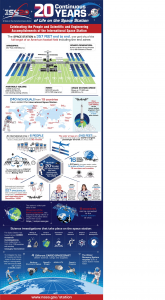 The International Space Station is a modular space station in low Earth orbit. It is a multinational collaborative project involving five participating space agencies: NASA, Roscosmos, JAXA, ESA, and CSA. The ownership and use of the space station is established by intergovernmental treaties and agreements.
The International Space Station is a modular space station in low Earth orbit. It is a multinational collaborative project involving five participating space agencies: NASA, Roscosmos, JAXA, ESA, and CSA. The ownership and use of the space station is established by intergovernmental treaties and agreements.
The station is divided into two sections: the Russian Orbital Segment (ROS), operated by Russia; and the United States Orbital Segment (USOS), which is shared by many nations. Roscosmos has endorsed the continued operation of ROS through 2024,having previously proposed using elements of the segment to construct a new Russian space station called OPSEK.The first ISS component was launched in 1998, and the first long-term residents arrived on 2 November 2000. The station has since been continuously occupied for 20 years and 32 days, the longest continuous human presence in low Earth orbit, having surpassed the previous record of 9 years and 357 days held by the Mir space station. The latest major pressurised module, Leonardo, was fitted in 2011 and an experimental inflatable space habitat was added in 2016. Development and assembly of the station continues, with several major new Russian elements scheduled for launch starting in 2020. As of December 2018, the station is expected to operate until 2030.
